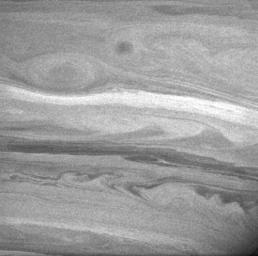Saturn, more bland in appearance than Jupiter to the naked eye, puts on a dramatic display in this contrast-enhanced image taken with the Cassini spacecraft. This view shows a giant oval in the ringed planet's southern hemisphere that is somewhat smaller than, but resembles in appearance, Jupiter's long-lived Great Red Spot.
On Jupiter such southern-hemisphere features usually exhibit counterclockwise -- or anti-cyclonic -- rotation, like high pressure systems on Earth. Imaging scientists will be interested to watch the evolution of this and similar storms, to see if it is longer-lived than is typical for Saturnian storms.
Also seen in the image at higher southern latitudes are the common dark belts and bright zones, usually associated with alternating eastward and westward jets. These jets often produce boundary turbulence (like that seen toward the bottom right) due to wind shear and density differences between adjacent bands.
The image was taken with the Cassini spacecraft narrow angle camera on Dec. 6, 2004, at a distance of approximately 3.3 million kilometers (2.1 million miles) from Saturn and at a Sun-Saturn-spacecraft, or phase, angle of 58 degrees. The filter used is centered at 727 nanometers -- an area of the electromagnetic spectrum where methane gas is strongly absorbing. The image scale is 38 kilometers (24 miles) per pixel. This image has been slightly contrast-enhanced to aid visibility.
The Cassini-Huygens mission is a cooperative project of NASA, the European Space Agency and the Italian Space Agency. The Jet Propulsion Laboratory, a division of the California Institute of Technology in Pasadena, manages the mission for NASA's Science Mission Directorate, Washington, D.C. The Cassini orbiter and its two onboard cameras were designed, developed and assembled at JPL. The imaging team is based at the Space Science Institute, Boulder, Colo.
For more information, about the Cassini-Huygens mission visit, http://saturn.jpl.nasa.gov and the Cassini imaging team home page, http://ciclops.org.

 Planetary Data System
Planetary Data System












